People
‘You Can Build Spaces That Mirror the Safety You Wish You Had’: Meet Artist Azikiwe Mohammed, Who Designs Safe Havens for Black People
The artist, who works in a broad array of media, treats art as a service.
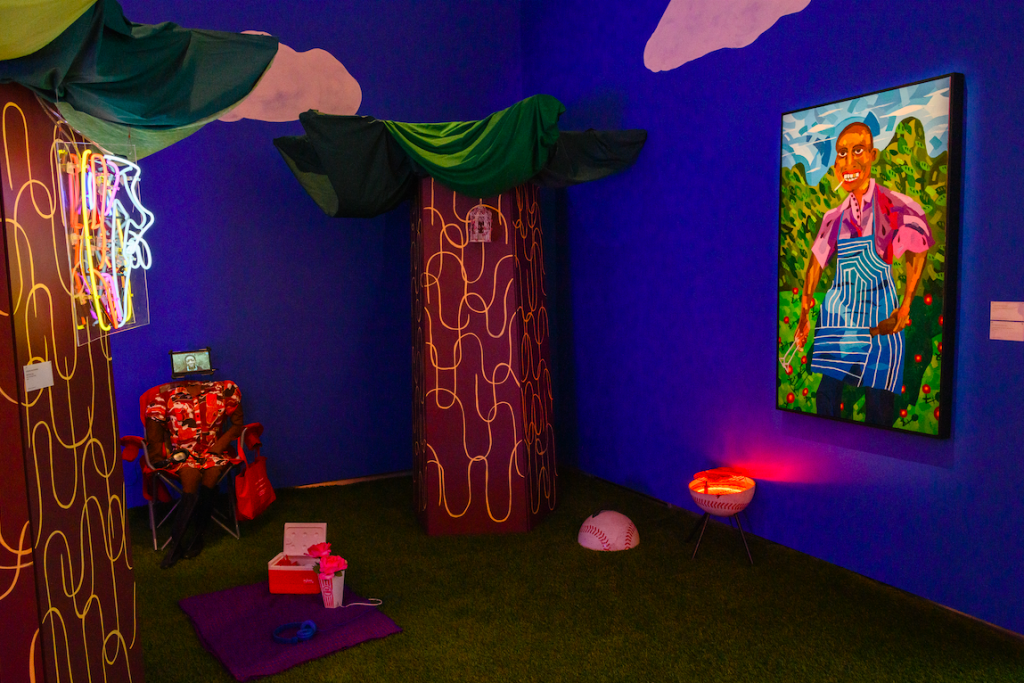
The artist, who works in a broad array of media, treats art as a service.

Arden Fanning Andrews

Azikiwe Mohammed was parked outside a Burger King next to the Studio Museum in Harlem, and the COVID-era world was changing.
“We don’t have a lot of physical spaces that we’re allowed to be in without having to buy something,” he said of the 125th Street Burger King, which was gated and abandoned in the wake of the pandemic. “You would think Burger King, you would have to buy something—you don’t. Just hang out, take a seat—a community room, right? So, seeing another one of those go always hurts.”
Azikiwe—who self-identifies not as an artist, but as a “dude who makes stuff”—often makes temporary homes and physical spaces for Black people. Sometimes he designs places to relax, environments where a shared language is spoken, or sometimes places where new languages can be created.
These familiar-yet-dreamlike environments, imbued with a sense of safety, are often multi-room, multi-dimensional experiences. For “Blackest Night: A Survey in Blackness” (2019), a show at the SCAD Museum of Art in Savannah, Georgia, Azikiwe designed a bridge, a park, a neon dinner table scene, mounted televisions, flickering projections, and wall after wall of tapestries, paintings, photos, and handcrafted treasures memorializing lost community members.
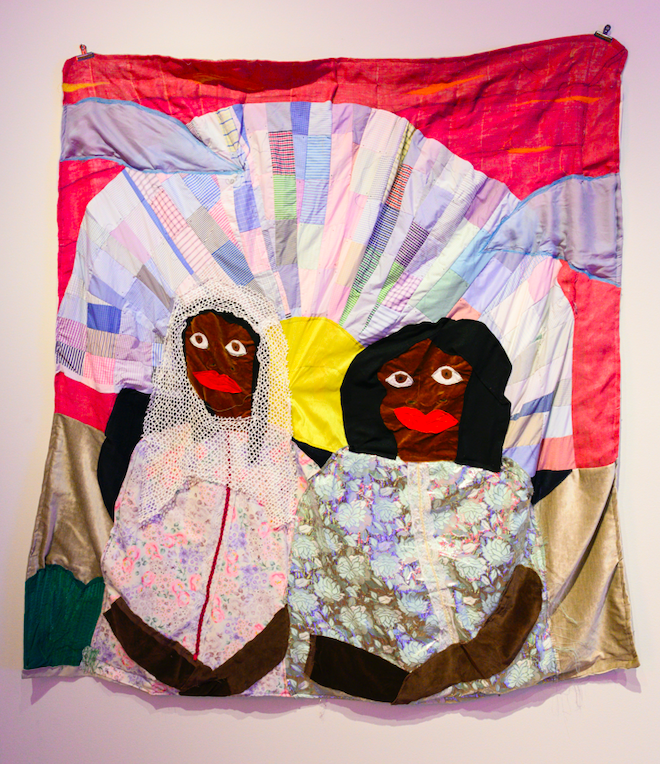
A detail from Azikiwe Mohammed’s show, “Blackest Night: A Survey in Blackness” at the SCAD Museum of Art.
“You can build non-threatening spaces,” he said. “You can build spaces that mirror the safety that you wish you had.”
And he doesn’t restrict himself. When I asked about the media that he had touched in the past year, Azikiwe, 36, rattled off bronze casting, jewelry fabrication, painting, neon bending, photography, performance, video, and sound work. It’s as if, like water, he’s constantly moving and reshaping the landscape.
His latest video work, Second Round, recently debuted in “FIVE.,” a virtual show curated by Nina Chanel Abney for the We Buy Gold gallery. (The show, which included works by Solange, Nick Cave, Ilana Harris-Babou, and others, ran through June, and nothing was for sale. Instead, the gallery asked viewers to donate to Project EATS’s COVID-19 Healthy Food Initiative.)
For Second Round, Azikiwe filmed New York beaches at dusk over multiple days as the basis for a surreal, 10-minute technicolor experience. The electric spectrum of sky, sand, and ocean in the film is accompanied by intermittent sounds of birds, applause, darkly cinematic synths, and waves.
“Every single time that we speak, I feel like I am getting introduced to yet another piece of him,” said We Buy Gold founder Joeonna Bellorado-Samuels.
“Like a vast home with seemingly endless rooms for every purpose, Azikiwe makes space for labor, play, retreat, learning, celebration, community, and memorial. And continuing with this analogy, there would definitely be a large and thriving garden with a body of water with depths that cannot be measured.”
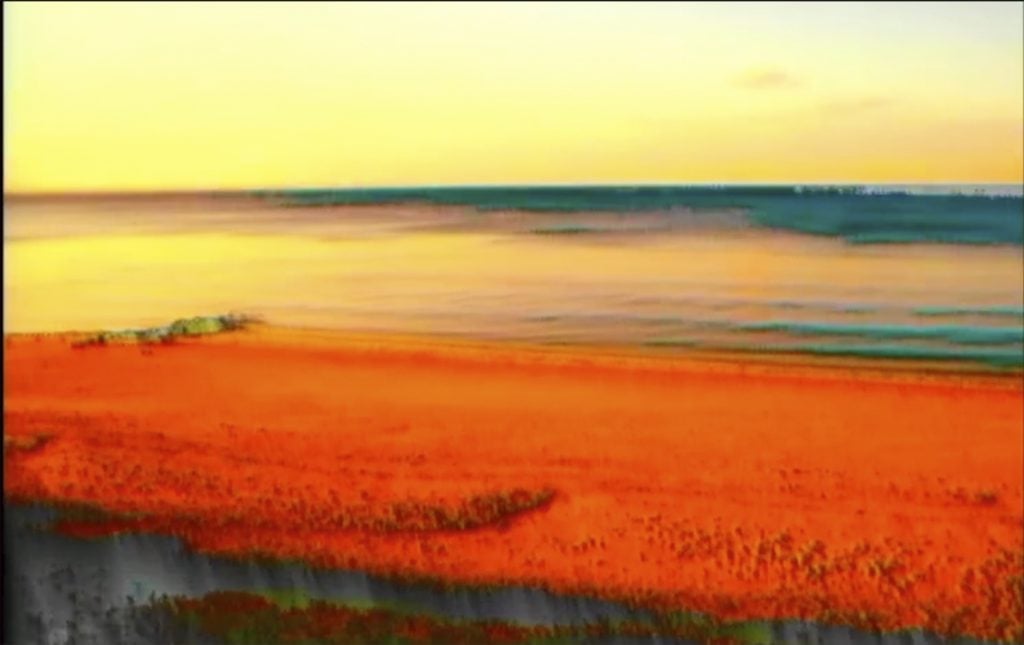
Azikiwe Mohammed, Second Round (image still, 2020).
Waves are a useful metaphor for the way Azikiwe thinks about his work.
“Blackness is 400 years old, and the only ground we have is ground we were brought here to give to someone else, to till for someone else, so our culture is in our body, not in the ground,” he said. “For us, to try and touch the rest of the world, it’s to grab a liquid ground that has been everywhere.”
“Rage is a wave that flows through you,” he added. “Anger comes in, makes itself at home, and then becomes part of you. Anger is part of the Black experience because where rage is more temporal, anger lives outside of time—but the waves keep coming. We are seeing one such wave now.”
As we spoke, a cop pulled up beside Azikiwe on 125th Street, which the artist described as one of his “favorite places on the planet.” Azikiwe paused, exhaled, and admitted it was “always terrifying” to see the police, even without a pointed interaction.
The possibility of death at the hands of police is constantly looming. Simultaneously, the Black Lives Matter movement has consumed America’s consciousness after the tragic police killings of Breonna Taylor and George Floyd. It’s an ongoing and horrifying reality that Azikiwe’s work has addressed for years: in Unarmed (2016), he created a jewelry board displaying gold and silver nameplates of unarmed Black people killed by police that year. In 2017, he made a series of works named after Meagan Hockaday, Tyisha Miller, Aiyana Jones, and Mya Hall, each of whom was killed by police between 1998 and 2015. There are 17 victims in that version of his series, which he said is an unfortunately an ongoing work.
“As a Black man living in America, you are born dead,” he said. “And every day that you successfully wake up is a triumph, is a cause for celebration, and is a chance to close out the receipts left open from yesterday.”
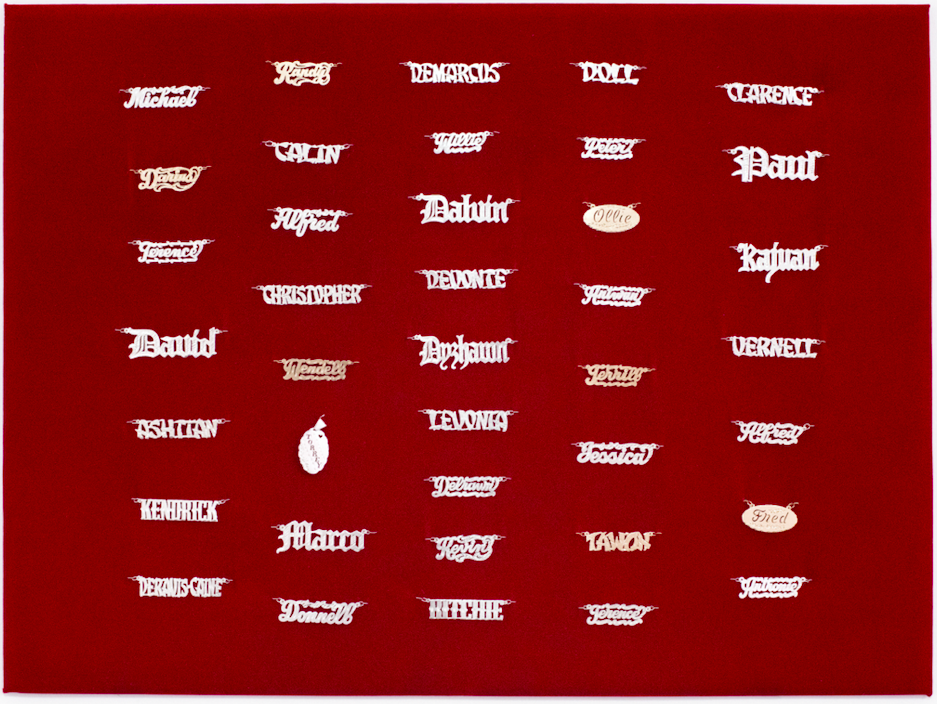
Azikiwe Mohammed, Unarmed (2016).
Azikiwe has shown work around the world: at the MECA International Art Fair in San Juan, Puerto Rico; the Material Art Fair in Mexico City; the Fabbrica del Vapore in Milan; Italy and at London’s 1:54 Contemporary African Art Fair.
A large amount of his work is about travel. For the photo series “From Here On Out,” he followed a path carved by the Underground Railroad and came up with the imagined town of New Davonhaime, which takes letters from the five most densely populated Black cities in America (New Orleans, Detroit, Birmingham, Jackson, and Savannah).
Throughout his travels, Azikiwe has gathered objects—photographs, ceramics, cameras, and various painted items—and has arranged them, along with works he made, for a project called Jimmy’s Thrift of New Davonhaime, which he has realized in various iterations at MoMA PS1, the Knockdown Center in Queens, the Ace Hotel in Chicago, and the Spring Break Art Show in New York.
The idea behind the work, he said, is to provide a respite from that which “plagues Black and other marginalized people in America.” It’s here that he asked guests to send him recordings of them retelling the first time they realized they were Black, which he then arranged for an audio project titled My First Time.
“Whenever I have these shows, I try to provide some form of service, if possible, [even if] it’s as simple as taking somebody’s picture and handing it back to them,” Azikiwe said. “I always try to build something in, because if I have access to the resources, it’s my responsibility to hand it back. We don’t get handed back things often.”
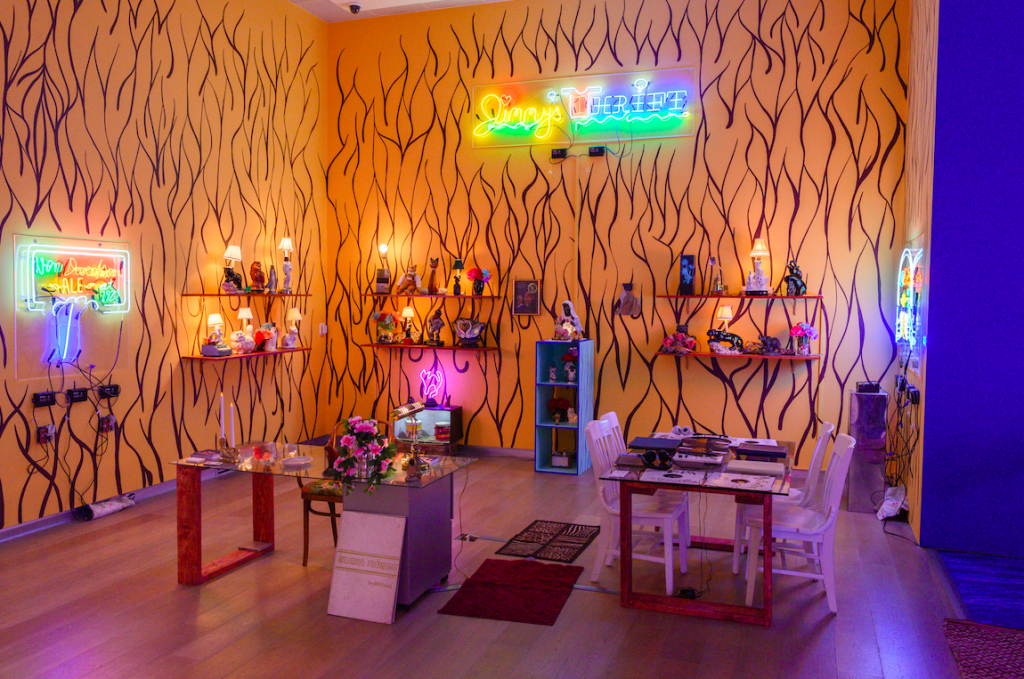
Azikiwe Mohammed, Jimmy’s Thrift of New Davonhaime at “Blackest Night: A Survey in Blackness” at the SCAD Museum of Art.
Azikiwe’s dad, a “man of many jobs,” died when the artist was in his 20s and continues to occupy his thoughts.
“He took pictures at schools, of nurses, up-and-coming Black bands, gospel churches,” Azikiwe said of his father. “It’s a form of representation that’s an externalization of self, difficult to achieve in other mediums and in general, so it’s always service. Art is a service position.”
Artist Leah Dixon has seen firsthand over the past 15 years how Azikiwe has connected with his subjects.
“Even though Azikiwe’s practice is very intentional and planned, he leaves a lot of space to spend time with the people he meets along his way,” she said, noting that “he forces us to become participants.”
Much of Azikiwe’s practice centers on performance as a means of being physically present—a feat many Black people aren’t allowed to perform.
“We get killed outside, we get killed in the house, we get killed in the cell—death surrounds us at every single point,” Azikiwe said of being Black in America. “We have to fight to stay alive, and that’s an enduring performance that is really tiring. No performer wants to perform for that long.
“It’s not that America is broken, it’s working the same as it always has,” he added. “This has always been a busted system, and that last bandaid just fell off. And thankfully, everybody’s on board.”